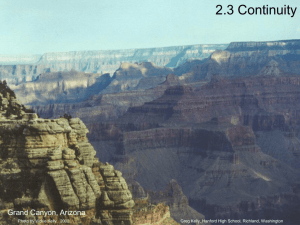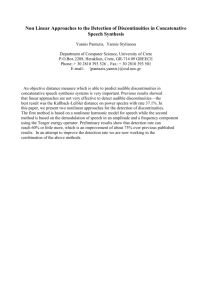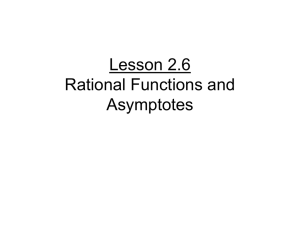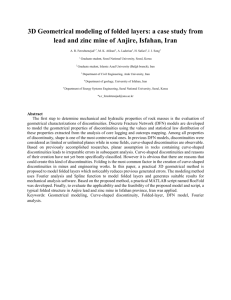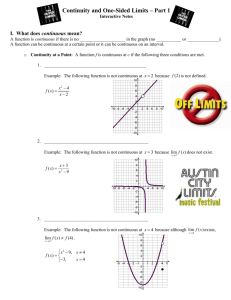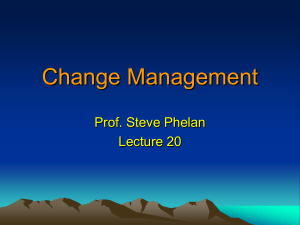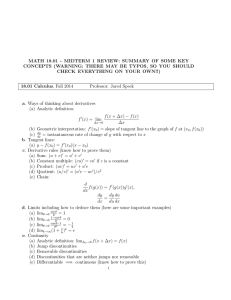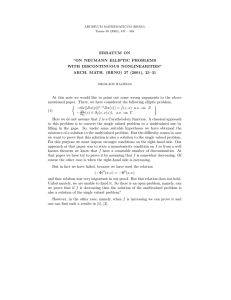Massachusetts Institute of Technology Artificial Intelligence Laboratory
advertisement
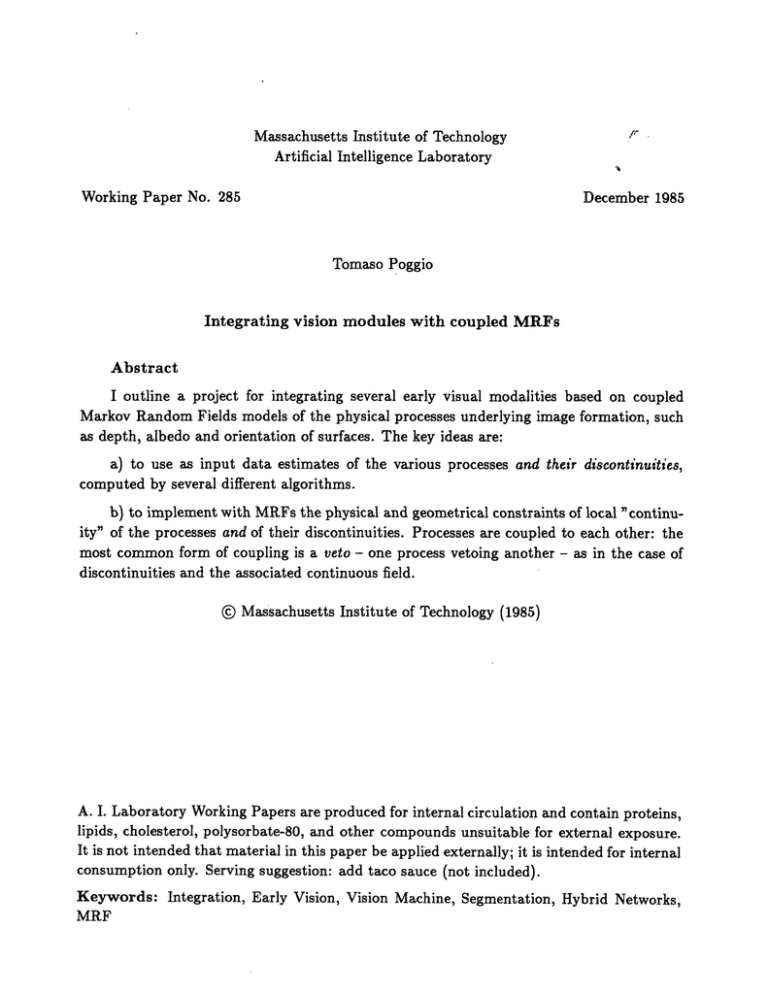
Massachusetts Institute of Technology Artificial Intelligence Laboratory Working Paper No. 285 December 1985 Tomaso Poggio Integrating vision modules with coupled MRFs Abstract I outline a project for integrating several early visual modalities based on coupled Markov Random Fields models of the physical processes underlying image formation, such as depth, albedo and orientation of surfaces. The key ideas are: a) to use as input data estimates of the various processes and their discontinuities, computed by several different algorithms. b) to implement with MRFs the physical and geometrical constraints of local "continuity" of the processes and of their discontinuities. Processes are coupled to each other: the most common form of coupling is a veto - one process vetoing another - as in the case of discontinuities and the associated continuous field. © Massachusetts Institute of Technology (1985) A. I. Laboratory Working Papers are produced for internal circulation and contain proteins, lipids, cholesterol, polysorbate-80, and other compounds unsuitable for external exposure. It is not intended that material in this paper be applied externally; it is intended for internal consumption only. Serving suggestion: add taco sauce (not included). Keywords: Integration, Early Vision, Vision Machine, Segmentation, Hybrid Networks, MRF Summary Coupled Markov Random Fields provide a powerful method for integrating different visual modules and for computing the equivalent of "intrinsic images" or a 21D sketch. This paper outlines the math and the underlying ideas of this project. An implementation is planned. 1) The key idea is that each visual modality (stereo, motion, texture, brightness and color, etc.) provides measurements to two (or more) MRFs: one is continuous (or a discrete approximation of a continuous field), the other is binary and corresponds to the discontinuities (that are critically important for segmentation in the VM project). Typically, at least two different algorithms per modality attempt to measure "continuous" values and discontinuities, respectively. For instance, a motion algorithm attempts to match features; a different "motion" algorithm attempts to find discontinuities in the motion field. In the same way, there may be an unconventional stereo algorithm for finding uncorrelated regions, that correspond to occlusions. Thus several processes and combinations of processes input data in the observable lattices. 2) The various MRFS mirror the different physical events that underly image formation: surface, surface discontinuities, spectral albedo, albedo discontinuities, shadows, surface normal, etc. 3) The local potentials underlying the a priori probability distribution of the MRFs represent the constraints on the physical processes (smoothness, positivity, bounds etc.); the coupling between MRFs represents the compatibility constraints between processes. 4) There are line processes (for discontinuities) and other types of binary veto processes. 5) The observable discontinuities provide a fast and coarse solution to the segmentation problem. Using the MRFs for estimating the fields give an increasingly more precise solution, simultaneously filling in the "continuous" regions that are only sparsely observable. The solution at each iteration is available to later processes. 6) A parallel architecture for finding optimal estimators based on this model is a multilayered, coupled, hybrid network with local planar interactions and sparsely coupled in depth. The Connection Machine is a good architecture for a first-order, fast implementation. This scheme may provide a metaphor for the control structure underlying early vision. It is possible, though - I believe - unlikely, that it will have a role in the VM project as an alternative control metaphor to, say, the blackboard. I will also discuss it from the point of view of evolutionary computation: is it possible to add layers (and their interactions) successively without reconfiguring the whole network? This leads to another broad question: how can the local potentials and the coupling interactions being improved by experience? (A similar scheme may be interesting for speech understanding). 1. Fusing modules makes vision systems possible A reliable and robust vision system must exploit the integration of several different vision algorithms and modalities. Not only contours but also stereo and motion and shading and colour give information about depth, for instance. In addition, it is not unlikely that several stereo algorithms are used. Whereas individual algorithms have to solve underconstrained problems the combination of several modules may overconstrain. A scheme that could integrate this redundant information seem the only serious possibility today for developing a vision system working on real images. Caution Note: As Shimon says even small children are very good at recognizing monocular, monochromatic, still line drawings. 2. The central role of discontinuities and their early detection I believe that the main first step towards recognition is to segment the image in regions that are likely to correspond to different objects. I believe that this segmentation pseudosegmentation - has to be done very early on. or As a consequence, the detection of discontinuities in the physical properties of surfaces has a critical role. There must be several different computations attempting to estimate the presence and the location of discontinuities. In some cases, discontinuities can be detected relatively easily. Several types of motion discontinuities can be measured quite efficiently with simple operations on the time dependent intensity array, especially if the interframe interval is very small (see the example of the fly's visual system). Albedo discontinuities may also be often detectable in terms of simple operations. What about stereo? So far, all stereo algorithms not only do not directly detect discontinuities in depth but perform badly precisely at occlusions. This state of affairs suggest the new idea that there may be a whole class of unexplored "stereo" algorithms with the goal of detecting some of the occluded, rivalrous regions. There is some faint evidence from psychophysics and physiology for this new role of "local" rivalry in depth perception (more is up to Heinrich). Notice that the goal of these early operations is a fast, rough detection of discontinuities in order to guide other processes that will help the refinement of this initial estimate. This point of view, if taken seriously, represents an almost complete turnaround of the "traditional" approach (see Grimson, Terzopoulos etc.) 3. Image Formation: the role of the physical processes The fraction of light reflected from an object for each wavelength A depends on the light source I(A), on the albedo p(x, A) and on the 3-D structure of the object. This last components can usually be described as a function of the directions of the viewer k, source s and surface orientation n. Let i, e, g be the angles between n and s, n and k, and k and s. This is expressed by S(x, A) = p(x, A)E(x, A) (1) where S(x, A) is the image, E(x, A) = I(A)R(k, s, n, A) is also called effective irradiance (see Hurlbert, 2001) and corresponds to the image produced by exactly the same 3-D scene painted white. If the effective irradiance of a scene can be found, one can then think of the albedo as a 2-D quantity: 3-D effects are all taken care of in E (and we are back to a flat Mondrian-like world!). R is the reflectance function of the object. The data measured by the sensors are: SV(x) = a(A)p(x, A)E(A, [f])dA, where v labels the spectral type of sensors (v = (2) 1, ...3 for R-G-B), a"(A) is the spectral sensitivity of the vth-type sensor (or filter) and SV(x) its output. p(A, •) is the surface albedo, E(A, f) is the effective irradiancethat takes into account 3-D shading effects and possibly shadows and f is the surface z = f(x, y). E is a functional of f (it usually depends on the surface normal (through R), see Appendix). Equation (2) shows that p and E cannot be determined from S and a uniquely without additional constraints. In any case, there is clearly a factor - the relative scaling of E and p - that cannot be determined unless the illuminant is observed directly. 4. Some constraints on the physical processes can be captured by MRF models 4.1. The physical processes Equation (1-2) show that some of the processes underlying image formation (under oversimplified assumptions) are 1) the surface depth z = f(x, y) 2) the albedo p(x, y, A) 3) the "effective irradiance" that usually depends on the surface normal and on the illuminations 4) the surface normal n or equivalently the gradient space p, q 5) the illumination I(x, y, A) (this may be a dual process corresponding to two light sources, a diffuse one and a point-like light source) 6) Other "minor" processes such as specularities or visible light sources that may locally "veto" or "switch off" some of the previous processes. Physical constraints apply to each of these processes independently. In addition, there are constraints between these processes (for instance between z and n). Equation 1-2 show how the image data constrain the way the processes combine. Notice that consideration of time dependence will introduce additional powerful constraints such as rigidity. In the following I will neglect this important extension since because of its computational complexity will not be taken into account in the first implementations. The constraints on z, n, p are local conditions (such as smoothness, necessary mainly because of its regularizing role in the face of omnipresent noise) valid everywhere but at discontinuities. The rationale for this is discussed elsewhere (see for instance Marr and also Poggio et al., 1985). Discontinuities are - as we discussed - critically important and detected very early. The machinery of coupled MRFs provides an ideal tool to impose the local constraints of smoothness (plus others, such as positivity, values within certain bounds, etc.) allowing at the same time an explicit role for discontinuities through the line process of Geeman and Geeman (and similar processes such as occlusions, etc. see Poggio and staff, 1985 and Marroquin et al., 1985). Here the new potentially powerful idea here is to have observable discontinuity processes measured by specialized algorithms in different visual modalities. Caution Note There are image properties however that do not seem easily captured by MRF models. This is the case for instance of shadows and their dependence on the illumination geometry and the surface values z = f(x, y). Intuitively, geometric constraints of this type seem more "global" than what a MRF model can usefully represent. It is an interesting question how to incorporate this in our present scheme. 4.2. The constraints on the physical processes We list here some of the constraints that can be exploited for each of the main processes (including the associated discontinuity process): a) Depth is smooth except at rare depth discontinuity lines that obey obvious geometric constraints of continuity. b) Typical illuminants and typical albedos have a finite (and small) number of degrees of freedom. In other words, they can be described as linear combinations of a fixed set of basis functions (notice that in different situations - such as different lighting conditions different bases may be required and that the illuminant basis is different, in general, from the albedo basis). This assumption - called the spectral regularizationassumption has been stated by several authors (see Hurlbert, 2001; for a recent review see Maloney, 1985). c) Typically, E(x), the "effective irradiance", changes with x more slowly than R(x, A) (apart from cases when surface changes abruptly or sharp shadows are present); d) p(x, A) is either constant or changes sharply (at material edges). In many scenes, it may be possible to assume that the average surface reflectance in each wavelength band is 'grey'. e) Usually, the effective irradiance has the same dependence on x at each A: E(x, A) = I(A)E(x) (3) This is equivalent to the assumption that R(x, A) in E(x, A) = I(A)R(x, A) (see equation (1)) is, to a sufficient approximation, independent of A. This is the single source assumption of Hurlbert and Poggio (see Hurlbert, 2001 and Poggio et al., 1985) f) The surface normal changes smoothly except at rare discontinuity lines g) The illumination is smooth everywhere apart from rare shadow boundaries where it changes discontinuously h) For the depth, albedo, effective irradiance and illumination, it is possible to assume certain upper and lower bounds for their admissible (or likely) values. i) Discontinuities in each of these processes are typically continuous boundaries, locally connected and non-intersecting. Assumption b) allows one to rewrite Equation 2 as S (x) = TC, eW(x)p, (x) (4) where the tensor T is defined as S=1 av(A)pi(A)q i (A)dA (5) where v = 1, ...3 and i,j = 1, ...N, the p's and the q's are the basis functions for the illuminant and for the albedo, respectively, and summation over repeated indices is tacitly assumed. Assumptions c) and d) mean that ei(x) will change slowly (apart from surface discontinuities) and pi(x) will be either constant or change sharply. Assumption e) means that ei(x) = e'e(x). Thus the ratio between the intensity SV(x) measured in one spectral channel and the intensity measured in another should change in a noiseless situation only at albedo boundaries (where the albedo changes), and should be invariant for changes in the effective irradiance. 5. Processes that deliver "continuous" data and processes that measure discontinuities There are several different algorithms to compute discontinuities in each of the physical processes. We list here some of them. More will have to be considered in future work. Depth discontinuities a) One of the standard stereo algorithms may provide an estimate of location of possible discontinuities by detecting regions of many weak matches, a situation typical for occlusions. A possible stereo algorithm may itself be based on a MRF formulation (Marroquin et al., 1985); furthermore a stereo algorithm can be coupled with the system outlined here in such a way that influences in turn the matching itself. b) A specialized stereo-rivalry algorithm may estimate regions that are likely to be occluded c) Motion discontinuities are usually an indication of depth discontinuities (especially in the case of self-motion) Albedo discontinuities From the image the quantity D(x) = is computed. ) (we assume here for simplicity v = 1, 2) Then we define the observation of the albedo discontinuity (Hurlbert and Poggio, 2010; see Poggio et al., 1985) pt(i) (where 1 denotes the line process) as pt(i) = 1 if an edge is detected at i and pI(i) = 0 otherwise. The presence of an edge is measured by one of the "standard" edge detectors operating on D(x). Another independent algorithm that estimates directly the albedo and the reflectance and could also be used simultaneously is Yuille's (1984; see also Maloney, 1985). Notice that useful information can be obtained if some properties of the illuminant can be measured (for instance by direct observation of the light source). Effective irradiance discontinuities To find the discontinuities in the scene irradiance (or effective irradiance) we find all edges in brightness and intersect this set with the set of albedo edges already found. The edges that are not common are likely to be discontinuities in the scene irradiance, due to either shadows or surface discontinuities or surface orientation discontinuities. precisely, we perform edge detection on the brightness b(i) = E SV(x)]. More We mark the locations where an edge is by setting dbL = 1 and otherwise dbj = 0. We then compute an estimate of the discontinuities in the effective irradiance as el(i) = dbl(i)(1 - Pt(i)), which marks sharp changes of intensity likely to correspond to sharp changes in effective irradiance but not changes in albedo (the threshold is set on the basis of noise estimates). Texture discontinuities mark places that are not generic discontinuities in the effective irradiance (they are not shadows and they are not sharp changes in the surface orientation). Surface normal discontinuities and illumination discontinuities They may be inferred exploiting additional information such as knowledge that the reflectance function is lambertian and labeling of brightness edges as shadows (using for instance measurements of texture on the two sides of an edge). There is much to do for developing several algorithms that provides the measurements of discontinuities in the different processes, exploiting different cues. It is especially important to have independent estimates of the same type of discontinuities: the weight they have, if two or more estimates coincide at a specific location, is large (see later), indicating very strongly the presence of a discontinuity. One possibility to be considered in a second stage is that these estimation processes are themselves coupled with the lattices of the physical processes. In this way the estimate of depth at time to in the 21D sketch will influence the operation of gathering depth data at later times (changing parameters in the input algorithm or by coupling to a MRF based stereo algorithm, see Poggio and Yuille, who are presently sweating about it). 6. 6.1. A model of Early Vision The basic physical processes The basic local constraints on the "continuous" physical processes can be captured by assuming that they are MRF. In this case their a priori probability distributions are Gibbs with basic potentials that I give here as a semi-serious illustration. I assume for simplicity time independent imagery (and relegating therefore motion to a secondary position: this is certainly not true for real-life, real-time vision) and 1-D notation. 1) The depth process is a MRF with a potential of the type U (z) = U(z(i),z(j)) = (z(i) - z(j))2 =0 fori-jl 1 otherwise (6) Lower and upper bounds on the depth process can be introduced with a potential term of the following flavor Uboun d = 0 = LN lb < z < ub otherwise (7) where LN is a large number. Depth can also be assumed to be piecewise constant in which case the potential equation (11) would be somewhat different. 2) Another (vector) MRF corresponds to the albedo p(x) with components in 2 or 3 spectral bands with values p(x) on the lattice. Assumption c) suggests a potential Up(p) = U(p,,pi) = #((Pi - Pj) 2 ) = 0 forli - jl = 1 otherwise where ((z) is a symmetric function that is 0 for z = 0, is large for small values of jzl, and may go to 0 again for large values of |zl (a standard Ising model may actuallly suffice, see Marroquin et al., 1985). In this way slow changes of p are penalized, whereas either constant values or sharp changes carry no cost. Lower and upper bounds on the albedo process (they are surprisingly strict because of the physics of surfaces) can be introduced with a potential term similar to equation (8). 3) The "effective irradiance" is defined as a (vector) MRF, corresponding to the illuminant components in 2 or 3 spectral bands with values e(x) on the lattice. We chose these to satisfy Assumption 2. For instance (neglecting vector notation because of TEX problems) Ue(e) = U(e, ej) = (e- - ej) 2 = 0 forli - l = 1 otherwise (9) Again, lower and upper bounds can be imposed with a potential term similar to equation (12). 4) The surface normal would also obey to a potential U, similar to the depth process. 5) The illumination I would have a potential Ui similar to U,. 6.2. Discontinuity processes In order to respect the previous assumptions that mostly impose smoothness everywhere except at (rare) discontinuities we introduce for each of the physical processes f a binary discontinuity process fi. This process has an associated potential reflecting the geometrical properties of boundaries (mainly that they are piecewise smooth curves, that there cannot be too many of them and that they do not intersect). I do not write explicitly these terms here. Their form is similar to Geman and Geman's and Marroquin's. The corresponding potentials are Uzz, Up,, Ue,, Us,, Ui,. 6.3. Coupling the "continuous" MRF to their (observable) discontinuities Each process f is coupled to its discontinuity by multiplying Uf with (1 - fL). 6.4. Introducing "continuous" observations We introduce the "continuous" data Z (depth) and S (color brightness) obtained as explained earlier by assuming that Z(x) and S (x) correspond to samples of signals affected by additive gaussian noise. The corresponding potential terms in the a posteriori distribution are of the type Uz=- (Z(i) - z(i)) 2 Us = 1-(-S((i) - T,e(i)p (i))2 (10) (11) 20 In equation (11) we have coupled the effective irradiance to the albedo. 6.5. Introducing discontinuous observations The discontinuity processes are observable in our framework. Their observation model has the typical potential u(yf,t) = a• (1 - 6(fi(i) - t(i))) (12) where 6 is the delta function, fd is the discontinuity process, and t is the observation. In the case of an error rate c for a binary symmetric channel a is a = In If more than one independent observation is available for the same discontinuity process (say two different algorithms estimate discontinuities in Z, providing the discontinuity indeces tl and t2) then each will contribute a term as the previous equation plus a joint term with a form of the type U, (fl,tl,t2) = X where X = In 6.6. (1 - 6(fd(i) - tl(i)t2(i))) (13) • Coupling the processes The irradiance equation equation 1) allows us to couple some of the processes. We have done this already for the effective irradiance and the albedo. If the reflectance is lambertian then equation 6 shows how I and R are coupled to E: under the assumption of gaussian additive noise (for instance) the corresponding potential term is of the form 12 6.7. (E(i) - I(i)R(i))2 (14) A very simple model In the case of just three processes (depth, albedo, effective irradiance) and their discontinuities, the total potential corresponding to the a posteriori Gibbs distribution is then Up(z,p,e, z, p,,e) = Uz + Us + (1 - z 1 )U, + (1 - pt)UP + (1 - el)Ue+ +Uz 1 + Upi + Uge + U(z, t) +... +Ubzound + ... (15) It is not too difficult to insert the additional terms corresponding to other processes such as surface normal etc. and their coupling. For instance, the surface normal would be coupled to the z process by a potential term of the form 2K2 6.8. z p) 2 + (z2y - q) 2 (16) Estimation As a performance criterion we will use a mixed criterion, where z, e and p should be as close as possible to their true values and we should make as few errors as possible in the assertion about the presence or absence of discontinuities. Thus the optimal estimates are the posterior mean for z and e' and pV (or the thresholded posteriori mean if they are processes with discrete values) and the maximizer of the a posteriori marginals for zz, pi, el, nl, it. We can compute these estimates by using Montecarlo methods of the type discussed by Marroquin (1985a,p. 132, 1985; see also Marroquin et al., 1985), running at a constant temperature. 7. 7.1. Conclusions The real problem and the implementation The main problems of this scheme are a) how to set the values of the coupling constants (they depend on noise estimate and on the "natural" temperature of the individual processes). Note that one expects possible discontinuous behaviour of the system as a function of the parameters because of its nonlinearity and cooperativity (think of the Ising model). b) computational complexity, possibly implying less-than-real-time performance even on powerful parallel computers. c) intrinsic locality of the Markov assumption that makes very difficult to consider more global properties, such as shadows. d) stationarity assumption underlying the probabilistic formulation. One way to explore these issues is to implement the scheme sketched in this paper (on the 3600 or even the CM). This is what I plan to do. 7.2. Extensions and alternatives A possible alternative application of MRFs that may be of special interest for the Vision Machine project, is to use MRFs on graphs instead than lattices (see Kindermann and Spell, 1980). In this way, it may be possible to integrate symbolic descriptions that are not pixel based as in the scheme of this paper. An important extension of the scheme outlined here is to time-dependent scenes. First, however, the sheme should show some promises on still imagery. Many other obvious extensions were not mentioned. Multiple scales must be taken into consideration; higher level control is needed; a small expert system may adjust the parameters of the coupled MRFs, depending on statistical measurements on the fields and a small set of heuristics. 7.3. An evolutionary view of computation The scheme outlined here is a possible control structure for a Vision Machine (though I do not believe it is the "right" approach). An ideal control structure would have the property that new modules can be added at will without having to change the control code. This property is important in a project like the CVM that involves several people and attempts to develop with time an increasingly sophisticated system. It must be essential to evolution which does not have ever the possibility to "rewrite" code from scratch when it becomes too unwieldy. Does the MRF model have this property? It seems possible that it may. When a new term is added to the potential it will not affect much the other lattices as long as the coupling constant is small. In a sense, it will be a kind of "neutral" mutation. For this reason it may be a good strategy to add new potential terms (corresponding to new processes or interactions among them) that at first are quadratic and have a small coupling coefficient. The constant may increase and their shape become less convex under selection pressure. 7.4. Learning A clearly important problem is to develop (possibly very slow) schemes to estimate the optimal parameters of the potential from examples of succesful computations. This may be the only practical way of setting the parameters of this model: learning from experience. Is this possible? As a side remark, that may or may not be relevant, I believe that learning can be succesfull only if the system has almost learned, in the following sense. One can think of learning as a two stage process: in the first stage, one sets up the representations, in the second stage, operators are learned. In a simple associative learning - for instance, learning to associate names to faces - learning requires setting the features to be used and then associating them. It can be proved that the general nonlinear "black-box" that has to be synthetized during learning is equivalent to two "boxes" corresponding to these two steps (Poggio, 1983). The first one can be regarded as a nonlinear coding step, whereas the second one is a linear operator. It is clearly tempting to think that a slow, almost exhaustive search, such as evolution, takes care of the first step whereas much faster "learning" synthetize the second "box". In a similar way, learning in our MRF model should probably be restricted to parameter estimation of an already existing model. 7.5. Connection with previous work Once this blurb was conceived and almost completely written, I discovered something I should have known, that is that Barrow and Tennenbaum (1978) had sketched ideas with a lot in common with the present scheme. In particular, they stated explicitely the photometric constraints, the use of intrinsic images corresponding to the physical processes undelying image formation, their local constraints, the role of discontinuities. They do not have the machinery of MRF and the equations to develop a succesfull implementation (they did not). They gloss over the "details" of how their model can be made to work. They do not have clear enough the role and the description of the processes that must measure properties of the fields and of their discontinuities. This, I believe, is a major point, which requires much research. This research, by the way, will be valid independently of whether the MRF-based fusion scheme proposed here is correct. It represents therefore the major justification for working on this project. 7.6. Work to be done I do not spell in detail the obvious and less obvious questions to be answered. There are several in the field of MRF theory, in estimation, in parallel implementations, in the development of efficient and simple algorithms for providing the initial measurements and especially in psychophysics, concerning the role of discontinuities, their early and independent detection and the fusion of information about different physical processes. Acknowledgments Thanks to Jim Little who not only signed but also read this draft and made several corrections and improvements. Appendix: Parenthesison lambertian surfaces Many surfaces can be modelled as combinations of Lambertian and specular surfaces. Lambertian surfaces look equally bright from all directions. Their reflectance function RL can be written as RL = s -n = cos(i) (Al) In many cases R depends only on the normal of the surface. An arbitrary point on a surface z = f(x, y) is given by r = (x, y, f(x, y)). (A2) The surface normal is 1 n =(-f 1 (1 + fX + fy2) /21), -l1)5 (A3) (A3) where fx and fy are the partial derivatives of f with respect to x and y. They are usually denoted by p and q respectively. The coordinate frame based on (p, q) is also called Gradient Space. In this space a planar patch ax + by + c = z corresponds to a point p = a, q = b. Using this notation the image irradiance equation becomes E(x, y, A) = I(A)R(p, q). (A4) READING LIST Brooks,M.J. and Horn, Berthold K.P. "Shape and Source from Shading", A.I. Memo 720 (1985) Buchsbaum, G. "A spatial processor model for object color perception," J. Franklin Inst., 310, 1980. Canny, John F. "Finding edges and lines," Massachusetts Institute of Technology Technical Report 720, 1983. Geman, Stuart, and Don Geman. "Stochastic relaxation, Gibbs distributions, and the Bayesian restoration of images," IEEE Trans. Pattern Analysis and Machine Intelligence, 6, 1984. Grimson, W.E.L. From Images to surfaces, Massachusetts Institute of Technology Press, Cambridge, Mass., 1981. Hillis, D. "The Connection Machine," Massachusetts Institute of Technology Department of Electrical Engineering and Computer Science Ph.D. Thesis, 1985. Horn, Berthold K.P. Robot Vision, MIT Press and McGraw-Hill (1985). Horn, B.K.P., "Obtaining shape from shading information", in: The Psychology of Computer Vision, P.H. Winston, ed., McGraw-Hill Publ., New York, 115-155, 1975. Horn, B.K.P., "Understanding image intensities", Artificial Intelligence, 8, 201-231, 1977. Hurlbert, Anya. "Color computation in the visual system," Massachusetts Institute of Technology Artificial Intelligence Laboratory Memo 814, 2001, in press. Kirkpatrick, S., Gelatt, C.D., Jr., and Vecchi, M.P. "Optimization by simulated annealing," Science, 220, 1983. Land, Edwin H. "Recent advances in retinex theory and some implications for cortical computations: colour vision and the natural image," Proceedings of the National Academy of Sciences, 80, 1983. Maloney, Laurence T. "Computational approaches to color constancy" Stanford University Tech. Report 1985-01, 1985. Marr, David. "Early processing of visual information," Phil. Trans. R. Soc. London B275, 1976. Marroquin, J. 1984 "Surface reconstruction preserving discontinuities," Massachusetts Institute of Technology Artificial Intelligence Laboratory Memo 792, 1984. Marroquin, J. "Optimal bayesian estimators for image segmentation and surface reconstruction," Massachusetts Institute of Technology Artificial Intelligence Laboratory Memo 839, 1985. Marroquin, J. "Probabilistic solution of inverse problems," Ph.D. Thesis, Massachusetts Institute of Technology , 1985. Marroquin, J., Mitter, S. and Poggio, T. "Probabilistic solution of Ill-posed problems in Computational Vision" Proceedings Image Understanding Workshop, Baumann ed., SAIC, 1985. Metropolis, N., A. Rosenbluth, M. Rosenbluth, A. Teller, and E. Teller. "Equation of State Calculations by Fast Computing Machines," J. Phys. Chem. 21, 1953. Poggio, T. and the staff "MIT Progress in Understanding Images", Proceedings Image Understanding Workshop, Baumann ed., SAIC, 1985. Poggio, Tomaso, Vincent Torre, and Christof Koch. "Computational vision and regularization theory," Nature 317, 1985. Rubin, John, and Whitman Richards. "Colour Vision: Representing Material Cat- egories," Massachusetts Institute of Technology Artificial Intelligence 764, 1984. Laboratory Memo 21 Terzopoulos, Demetri. "Regularization of inverse visual problems involving discontinuities," IEEE Trans. Pattern Analysis and Machine Intelligence, 1986, in press. Yuille, Alan L. "A method for computing spectral reflectance," Massachusetts Institute of Technology Artificial Intelligence Laboratory Memo 752, 1984. I I IN N N N N N ~ N N N -. '-4 -o 0 J Ph a4 m m o P r -tl rm -l FROM EARLY PROCESSING FROMEARLY PROCESSING
